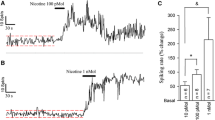Abstract
Intravenous administration of methylphenidate (1 or 2 mg/kg) markedly attenuated the unit discharge rate in the mesencephalic reticular formation of rats and cats. Concurrently this drug enhanced the neural activity in the primary sensory nuclei of the thalamus. The differential effects of methylphenidate on these two neural systems suggest a possible mechanism by which it may improve attentive processes in hyperkinesis.
Similar content being viewed by others
References
Bender, L., Cottington, F.: The use of amphetamine sulfate (Benzedrine) in child psychiatry. Amer. J. Psychiat. 99, 116–121 (1942)
Bradley, C.: The behavior of children receiving benzedrine. Amer. J. Psychiat. 94, 577–585 (1937)
Bradley, P. B.: The central action of certain drugs in relation to the reticular formation of the brain. In: The Reticular Formation of the Brain, H. H. Jasper, L. D. Proctor, R. S. Knighton, W. C. Noshay, and R. T. Costello, eds., pp. 123–149. Boston: Little Brown 1958
Conners, C. K.: The use of stimulant drugs in enhancing performance and learning. In: Drugs and Cerebral Function, W. L. Smith, ed., pp. 85–98. Springfield, Ill.: C. C. Thomas 1969
Ellinwood, E. H.: Amphetamine psychosis: I. Description of the individuals and the process. J. Nerv. Ment. Dis. 144, 273–283 (1967)
Feldman, S. M., Waller, H. J.: Dissociation of electrocortical activation and behavioral arousal. Nature (Lond.) 196, 1320–1322 (1962)
Khachaturian, Z. S., Gluck, H.: The effects of arousal on the amplitude of evoked potentials. Brain Res. 14, 589–606 1969)
Knobel, M.: Psychopharmacology for the hyperkinetic child. Arch. Gen. Psychiat. 6, 198–202 (1962)
Lacey, J. I.: Somatic response patterning and stress. Some revisions of activation theory. In: Psychological Stress, M. H. Appley and R. Trumbull, eds., pp. 14–42. New York: Appleton-Century-Crofts 1967
Laufer, M. W., Denhoff, E., Solomons, G.: Hyperkinetic impulse disorder in children's behavior problems. Psychosom. Med. 19, 38–49 (1957)
Lightfoot, O. B.: Hyperactivity in children. J. nat. med. Ass. (N.Y.) 65, 58–62 (1973)
Lindsley, D. B.: Attention, consciousness, sleep and wakefulness. In: Handbook of Physiology, J. Fields, H. W. Magoun and V. E. Hall, eds., Section 1, Vol. 3, pp. 1553–1593. Washington, D. C.: American Physiology Society 1960
Lindsley, D. B., Schreiner, L. H., Knowles, W. B., Magoun, H. W.: Behavioral and EEG changes following chronic brain stem lesions in the cat. Electroenceph. Clin. Neurophysiol. 2, 483–498 (1950)
Millichap, J. G.: Drugs in the management of hyperkinetic and perceptually handicapped children. J. Amer. Med. Ass. 206, 1527–1530 (1968)
Millichap, J. G., Fowler, G. W.: Treatment of “Minimal brain dysfunction” syndromes: selection of drugs for children with hyperactivity and learning disabilities. Pediat. Clin. N. Amer. 14, 767–777 (1967)
Pellegrino, L. J., Cushman, A. J.: A Stereotaxic Atlas of the Rat Brain. New York: Appleton-Century-Crofts 1967
Rheinberger, M., Jasper, H. H.: Electrical activity of the cerebral cortex in the unanesthetized cat. Amer. J. Physiol. 119, 186–196 (1937)
Sainz, A.: Hyperkinetic disease of children: diagnosis and therapy. Dis. Nerv. Syst. 27, 48–50 (1966)
Satterfield, J. H., Cantwell, D. P., Satterfield, B. T.: Patho-physiology of the hyperactive child syndrome. Arch. Gen. Psychiat. 31, 839–844 (1974)
Satterfield, J. H., Dawson, M. E.: Electrodermal correlates of hyperactivity in children. Psychophysiology 8, 191–197 (1971)
Scheibel, M. E., Scheibel, A. B.: Anatomical basis of attention mechanism in vertebrate brains. In: The Neurosciences: A Study Program. G. C. Quarton, T. Melnechuk, and F. O. Schmitt, eds., pp. 577–607. New York: The Rockefeller University Press 1967
Shih, T.-M., Khachaturian, Z. S., Reisler, K. L., Barry, H., III, Kerr, J. L.: The effects of methylphenidate on selective sensory information processes. Fed. Proc. 33, 293 (1974)
Snider, R. S., Niemer, W. T.: A Stereotaxic Atlas of the Cat Brain. Chicago-London: University of Chicago Press 1970
Stevens, J. R., Sachdev, K., Milstein, V.: Behavior disorders of childhood and the electroencephalogram. Arch. Neurol. (Chic.) 18, 160–177 (1968)
Tecce, J. J., Cole, J. O.: Amphetamine effects in man: Paradoxical drowsiness and lowered electrical brain activity (CNV). Science 185, 451–453 (1974)
Weiss, B., Laties, V. G.: Enhancement of human performance by caffeine and the amphetamines. Pharmacol. Rev. 14, 1–36 (1962)
Wender, P. H.: Some speculations concerning a possible biochemical basis of minimal brain dysfunction. Life Sci. 14, 1605–1621 (1974)
Werry, J. S.: Developmental hyperactivity. Pediat. Clin. N. Amer. 15, 581–599 (1968)
Wikler, A., Dixon, J. F., Parker, J. B.: Brain function in problem children and controls: Psychometric, neurological and electroencephalographic comparisons. Amer. J. Psychiat. 127, 634–645 (1970)
Author information
Authors and Affiliations
Additional information
Partially supported by USPHS Research Grant MH-19426 to Z.S.K., Training Grant GM-1217 for T.M.S., and Research Scientist Development Award K2-MH-5921 to H.B., III.
Rights and permissions
About this article
Cite this article
Shih, T.M., Khachaturian, Z.S., Barry, H. et al. Differential effects of methylphenidate on reticular formation and thalamic neuronal activity. Psychopharmacologia 44, 11–15 (1975). https://doi.org/10.1007/BF00421176
Received:
Revised:
Issue Date:
DOI: https://doi.org/10.1007/BF00421176




